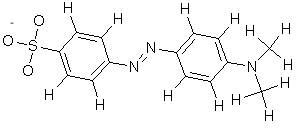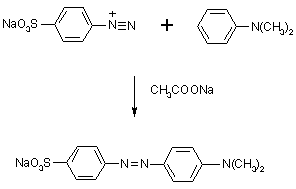
Home
Common Compounds
Exam Guide
FAQ
Features
Glossary
Construction Kits
Companion Notes
Just Ask Antoine!
Simulations
Slide Index
Toolbox
Tutorial Index
Introduction
Measurement
Matter
Atoms & ions
Compounds
Chemical change
The mole
Gases
Energy & change
The quantum theory
Electrons in atoms
The periodic table
Chemical bonds
Solids
Liquids
Solutions
| Acids & bases |
Reaction rates
Organic chemistry
Everyday chemistry
Inorganic chemistry
Environmental chemistry
Laboratory
History of chemistry
Miscellaneous
Home  FAQ FAQ  Acids and bases Acids and bases | Print | Comment |
| Previous Question | Next Question |
What is methyl orange? How is it made?
-
-
Methyl orange is an intensely colored compound used in dyeing and printing textiles. It is also known as C.I. Acid Orange 52, C.I. 13025, helianthine B, Orange III, Gold orange, and Tropaeolin D [1].
Vocabulary azo compound 
diazonium salt
diazotization
indicator
pH
strong acid
titration
weak base
Chemists use methyl orange as an indicator in the titration of weak bases with strong acids. It changes from red (at pH 3.1) to orange-yellow (at pH 4.4):


pH-related color changes result from changes in the way electrons are confined in a molecule when hydrogen ions are attached or detached. Here is the structure of methyl orange in acidic solution:
The molecule absorbs blue-green light, which makes its solution appear red. Notice that the nitrogen bearing the positive charge is involved in a double bond.
Methyl orange in acidic solution.
Click the image for a 3D Chime structure.In the basic form of methyl orange, a hydrogen ion is lost from the -NN- bridge between the rings, and the electrons formerly used to bind the hydrogen neutralize the positive charge on the terminal nitrogen, so that it is no longer able to pi-bond. Solutions of the methyl orange appear yellow in alkaline solution [2].

Methyl orange in basic solution.
Click the image for a 3D Chime structure.How is methyl orange made?
Methyl orange is synthesized by reaction of sulfanilic acid, sodium nitrite, and dimethylaniline. First, sulfanilic acid is dissolved in dilute aqueous acid. Sodium nitrite is added to produce a diazonium salt

This reaction is called diazotization and it is extremely useful in organic synthesis. The nitrous acid provides NO+ which replaces a hydrogen on the -NH3+ group to produce -NH2NO+ and water; a second water is eliminated to produce the -N2+ group.
The diazonium salt is then coupled with dimethylaniline. The coupling takes place in the opposite ("para") position from the -N(CH3)2 group:

The sodium acetate makes the solution weakly basic; the acetate ion accepts the hydrogen displaced from the dimethylaniline ring.
References and notes
- The Merck Index, 8th ed., Merck & Co., Rahway NJ, 1968. The index gives the following reference for details on the synthesis
of methyl orange:
L. Gattermann, Die Praxis des organischen Chemikers, 40th ed., de Gruyter & Co., Berlin, 1961, pp 260-261. - For more about the molecular basis of indicator color changes, see Water to Wine.
- The Merck Index, 8th ed., Merck & Co., Rahway NJ, 1968. The index gives the following reference for details on the synthesis
of methyl orange:
General Chemistry Online! What is methyl orange? How is it made?
Copyright © 1997-2010 by Fred Senese
Comments & questions to fsenese@frostburg.edu
Last Revised 02/23/18.URL: http://antoine.frostburg.edu/chem/senese/101/acidbase/faq/methyl-orange.shtml